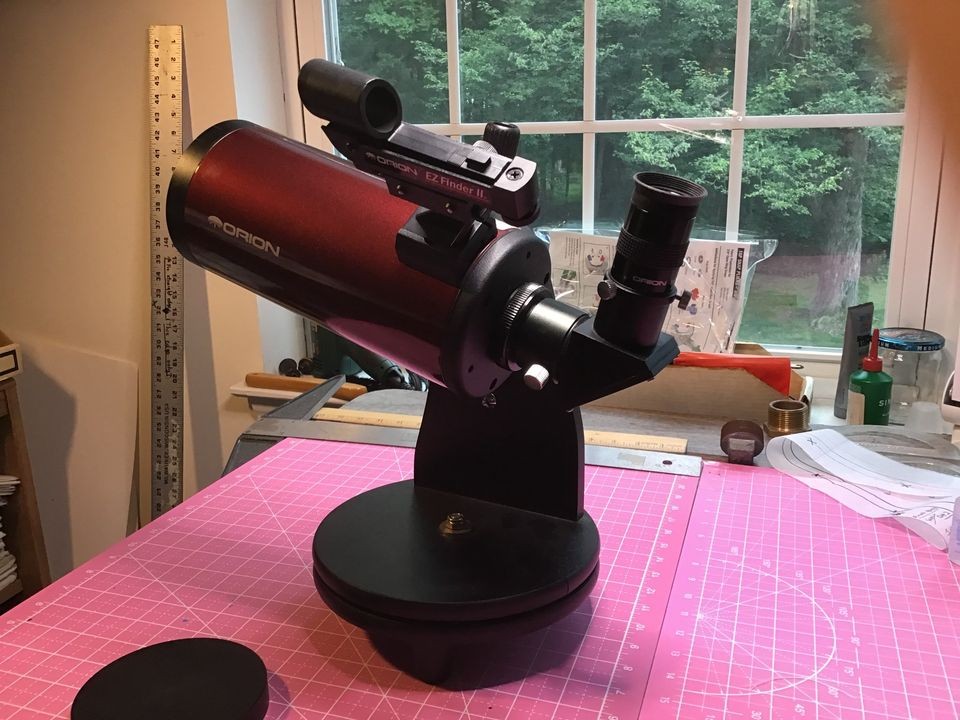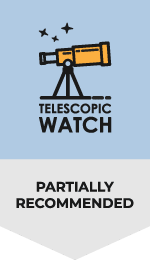The Optical Tube Of Starmax 90mm
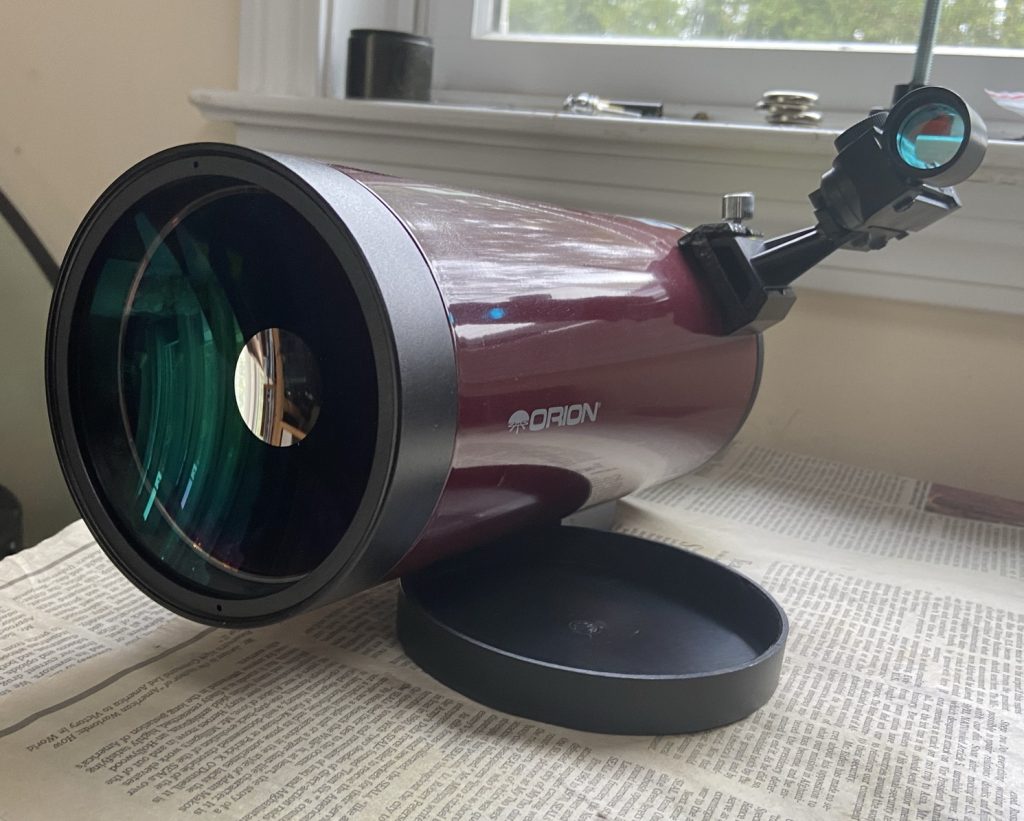
You might be forgiven at first for thinking the StarMax 90mm Tabletop is related to or derived from the Virtuoso 90 or C90 from Sky-Watcher/Celestron. For a long time, the StarMax 90mm Tabletop was indeed the same telescope as those two.
I was then surprised to learn that due to Orion’s divorce with Synta (the parent of Sky-Watcher and Celestron and formerly a large supplier of Orion), Orion decided to cheapen out the scope and its accessories. I’m extremely disappointed that the StarMax 90mm Tabletop now has a largely plastic build, including the exterior of the tube itself.
The present-day StarMax 90mm Tabletop seems to be made by JOC/Bresser, who are also the OEM for Explore Scientific telescopes and many of Orion’s other offerings nowadays.
Fortunately, the optics at the heart of the StarMax 90mm Tabletop haven’t changed. It’s still a 90mm (3.5 inch) f/13.9 Maksutov-Cassegrain telescope with a 1250mm focal length.
Why Are Maksutov-Cassegrains Considered Superior?
The Maksutov-Cassegrain design uses a spherical primary mirror with a spherical corrector plate, as I’ve illustrated in the diagram below. The StarMax 90 and the majority of other mass-produced Maks use the Gregory-Maksutov design, where the secondary mirror is simply an aluminized portion on the corrector plate’s back.
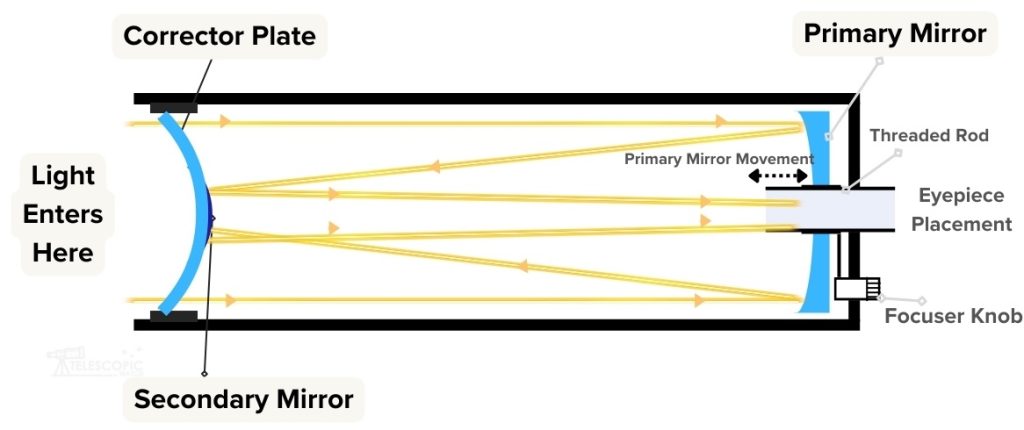
Maksutov-Cassegrain telescopes have fairly lenient manufacturing and alignment tolerances because they have only three surfaces on two pieces of glass to worry about, and all of them are spherical curves. As a result, they produce world-class images for their aperture. The StarMax 90mm Tabletop is no exception, with sharp stars across the periphery of its (relatively narrow) field of view.
Focusing the StarMax 90mm Tabletop is done the same way as with most other catadioptrics.
As shown in the diagram above, when you turn the focus knob on the back of the optical tube, the primary mirror moves back and forth on a rod within the optical tube. This focusing, when done on telescopes with larger mirrors, often leads to image shift, an apparent wobble of the view that happens due to the primary mirror rocking on its support as it travels back and forth. But fortunately, the StarMax’s 90mm mirror is too small for a significant image shift to happen.
Collimation Requirements
The StarMax 90mm Tabletop has 3 hex head collimation screws for adjusting the primary mirror.
Although Maksutov-Cassegrains rarely, if ever, fall out of collimation, these screws can be used to collimate the scope if need be. These screws are recessed at the back of the telescope and push on an assembly between the rear of the tube and the primary mirror. They should be firmly tightened, and only small adjustments are needed to fix any miscollimation of the telescope.
A Note on the 1.25″ Visual Back
Your star diagonal, eyepieces, or other accessories attach to a visual back, or ‘eyepiece holder’, at the back end of the optical tube and remains stationary when we adjust focus.
The 1.25” visual back attached to the StarMax 90mm Tabletop is not the same as a Schmidt-Cassegrain visual back, though adapters are available to attach such. But it has built-in T-threads to attach your DSLR and use the telescope as a long focal length telephoto lens.
Due to the 1.25”-only format of this telescope and its long 1250mm focal length, the maximum field of view I was able to get with the StarMax 90mm Tabletop was about 1.3°, or two and a half times the angular diameter of the full Moon or Sun in the sky.
Adding Starmax To Other Mounts
Like many other telescopes, the StarMax 90mm Tabletop’s optical tube has a Vixen dovetail bar with ¼ 20 threaded holes, so it can be used on any compatible mount that accepts a Vixen dovetail, or it can be directly attached to a photo tripod. Unfortunately, I also discovered that this dovetail is now made entirely out of plastic, but it still does the job.
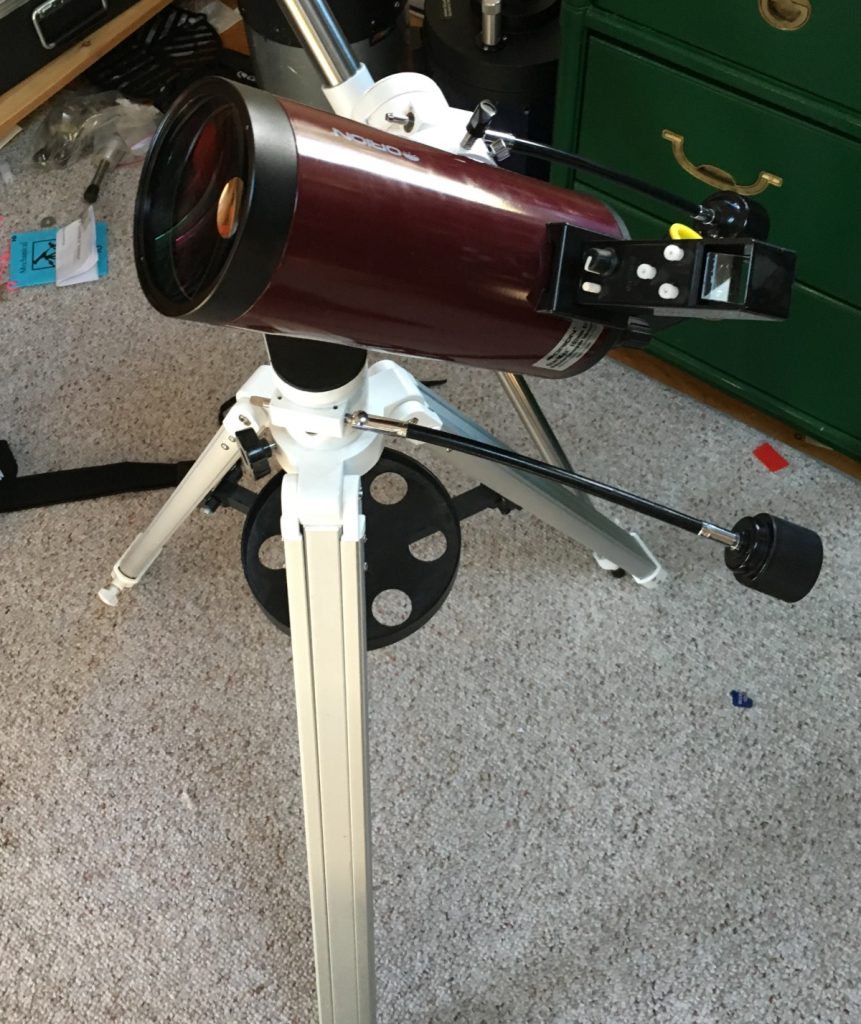
Quality of Accessories
The StarMax 90mm Tabletop comes with two 1.25” interchangeable eyepieces: a 25mm Kellner (50x) and a 10mm Kellner (125x). Both use glass lenses, though the body of each eyepiece is disappointingly plastic. At f/13.9, I view them as more than acceptable, and the 10mm provides us plenty of magnification for close-up lunar and planetary views.
The 1.25” star diagonal included with the StarMax 90mm Tabletop used to be a high-quality 90-degree prism. I’ve now found out that Orion has swapped this with a low-quality mirror diagonal of dubious flatness. I believe that an aftermarket diagonal will have brighter and clearer images and would be a good investment for this telescope.
For aiming, the StarMax 90mm Tabletop includes a standard battery-powered red dot finder that slides into its (also plastic) Vixen/Synta universal finder shoe attached to the side of the tube. This finder is more than adequate for aiming this small telescope at most targets.
Finally, a cheap screw-on “moon filter” (in fact, a 13% transmission neutral density filter) is thrown in with the StarMax 90. This device, designed to attach to the end of the star diagonal or one of your eyepieces, is something I find quite silly. Not only does it dim the view far too much for this small telescope, but its low-quality glass blurs my view of our nearest neighbor. I don’t see any no harm in observing the moon’s full, unfiltered brightness through any telescope.
In my opinion, moon filters are not a necessary accessory and are little more than a marketing tactic to get you to waste money on a few cents’ worth of tinted glass.
The Dobsonian Mount with Starmax 90
The StarMax’s tabletop mount is the same “Dobsonian” single-arm mount supplied with most inexpensive tabletop scopes, which are almost always Newtonian reflectors. However, those Newtonian reflector tabletops’ shorter-focal-lengths make them more suited for wide-field, low-power use, where the ability to fine-tune the scope’s position isn’t as crucial.
But from my experience, unlike with Newtonian tabletops, using a tabletop Dobsonian mount with a Maksutov like the StarMax 90, which is primarily a high-power instrument, can be frustrating and tedious to use.
The StarMax’s extremely short tube make fine adjustments even more difficult, as its harder for me to use the tube as a lever to pivot the instrument accurately. If you have large hands, like myself, it can be hard to aim the telescope without grossly over-adjusting or obstructing most of the aperture as you attempt to maneuver the scope around the sky. This being said, the mount is very steady once I get it on target, but I’m inclined to believe that it is certainly not the best mount that could be supplied for a 90mm Maksutov-Cassegrain design.
The StarMax’s tabletop Dobsonian mount has a ¼ 20 hole at the bottom that allows the whole telescope assembly to be attached to a photo tripod, which is nice if you don’t want to use a table. At the scope’s weight of 6.5 pounds (2.94 kilograms), however, I’d need to make sure to use a relatively heavy-duty photo tripod for such a task.
Should I buy a used Orion StarMax 90mm Tabletop?
The pre-2023 StarMax 90mm Tabletop is a different telescope from the one Orion sells now. I mean, it’s basically identical to the Celestron C90 or the 90mm Maksutovs offered by Celestron, and that goes hand-in-hand with an all-metal build. The tabletop mount is the same and has the same shortcomings, but the older-gen StarMax’s included star diagonal and eyepieces are up a notch quality-wise (the provided diagonal is a prism, and a good one at that).
If you either don’t mind the limitations of a tabletop mount with high-power telescopes or plan on using a different mount, there’s little that can go wrong with a used StarMax 90, pre-2023, or the newer kind.
The sealed nature of the optical tube means you’re unlikely to find one with damaged optics. However, a unit with damage to either the mirror or a cracked corrector should be avoided; recoating the secondary mirror is nigh-impossible, and it is not cost-effective to recoat the primary or replace the corrector/secondary assembly.
Alternative Recommendations
The Sky-Watcher Virtuoso 90 uses a similar 90mm Maksutov-Cassegrain optical tube to the Orion StarMax 90, but with substantially less plastic. Its Virtuoso tabletop mount has full motorized tracking abilities with push-button control of fine adjustment for aiming, along with a solar filter bundled in by default. Like the StarMax 90, it works either on a tabletop or with a sturdy photo tripod attached to the bottom.
For more information on what telescope is best for you and your budget, check out our Telescope Rankings and Best Telescopes articles.
Aftermarket Accessory Recommendations
The 90-degree mirror star diagonal included with the Orion StarMax 90mm Tabletop telescope is pretty bad; I’d recommend Celestron’s 1.25” prism diagonal or a high-quality 1.25” dielectric unit to get the sharpest views possible.
And while workable, the eyepieces included with the StarMax are not exactly of the highest quality. A 32mm Plossl eyepiece, for instance, provides a lower 39x and a 1.3-degree true field with the StarMax 90mm Tabletop, which is a bit more optimal for viewing deep-sky objects or initially locating your target. A 9mm “redline” or “goldline” ocular can be swapped in for the provided 10mm, yielding 139x—ideal for lunar, planetary, and double star views—along with a wider, sharper field than the 10mm Kellner design. A 6mm redline/goldline will provide 208x with the StarMax 90, which is a little bit much for the telescope’s optics to handle and will require steady skies to benefit from.
What can you see?
The Orion StarMax 90mm tabletop telescope, with its precision optics, is primarily tailored for solar system observations.
It offers viewers the opportunity to witness the phases of Mercury and Venus, the intricate details on the Moon’s surface, including craters and mountain ranges, and the polar ice caps on Mars. Jupiter’s vibrant cloud belts, the prominent Great Red Spot, and its four major moons are discernible, with the added bonus of observing the moons’ transits and their shadows on the planet when these occur. Saturn’s iconic rings, including the Cassini Division bisecting them, present themselves with clarity, and observers can also identify some of Saturn’s moons. Uranus and Neptune are visible, but they will look like little more than stars and might be quite challenging to locate.
With its sharp optics, the StarMax 90mm Tabletop also offers a delightful experience for double-star observers. The telescope can split thousands of co-orbiting binary stars, revealing their colors and separating close pairs up to its theoretical Dawes limit, even under less-than-ideal sky conditions.
Unfortunately, the StarMax 90’s small aperture limits it to only the brightest deep-sky objects, and some large open star clusters and nebulae may not fit in the field of view of the telescope, even at low magnification. You’ll also likely have issues finding these objects, given the scope’s narrow field of view and feeble light grasp.
However, smaller objects such as the Ring Nebula, M11, the Orion Nebula, and M35, among others, are still enjoyable to look at and reasonably easy to find. Galaxies like Andromeda might be perceivable, but they’ll appear as faint smudges, especially in areas with significant light pollution. Globular star clusters, on the other hand, will mostly appear as indistinct, hazy balls of light. For those keen on exploring the depths of the cosmos and seeking detailed views of these deep-sky objects, telescopes with larger apertures would be more suitable, such as a 4-5” tabletop Dobsonian in this price range.
Astrophotography Capabilities
The Orion StarMax 90’s direct T-thread attachment on the scope’s visual back means that you can screw it to a camera for use as a telephoto lens. Likewise, atop its provided mount or a photo tripod, I’m sure it makes for a great daytime spotting scope.
Astrophotography of the Moon with a smartphone is easy to do with any telescope; I’ve written a whole guide on it for you.
You can also use the StarMax 90mm Tabletop with a planetary camera to create stacked close-up images of Solar System objects, though you’ll want a different mount that offers motorized tracking of some sort.

